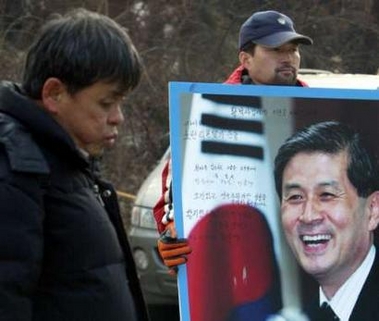|
Investigators: Hwang never produced patient-specific stem cells
(AFP)
Updated: 2005-12-29 14:13
Investigators have said disgraced South Korean scientist Hwang Woo-Suk never
produced any patient-specific stem cells, as he claimed.
"We found that Hwang and his team have no scientific data to prove that they
had produced patient-specific stem cells," a nine-member investigative committee
from Hwang's Seoul National University said.
"DNA tests showed there were no patient-specific stem cells," committee
spokeswoman Roh Jung-Hye said.
Hwang was hailed as a national hero in South Korea until the university
committee accused him last week of fabricating key parts of his groundbreaking
research on the production of patient-specific stem cells.

A South Korean man supporting stem-cell
scientist Hwang Woo-suk holds a portrait of Hwang in front of Seoul
National University in Seoul December 29, 2005.
[Reuters] | Hwang resigned a week ago after requesting that the US magazine Science
retract his 2005 research paper, but he insisted that he indeed had the
technology to make the tailored stem cells.
Stem cells are the body's master cells which experts believe can grow into
any organ and thus someday can be used to help fight cancer and other diseases
such as Alzheimer's, Parkinson's and diabetes.
Patient-specific cells would reduce the risk of rejection.
The committee, however, said the five cell samples thawed and analyzed were
confirmed to be stem cells extracted from a fertilized egg created by Seoul's
Mizmedi hospital, which had collaborated with Hwang's research team.
Roh said the committee has yet to complete its investigation into doubts
about Hwang's other work including a 2004 paper on producing the world's first
cloned embryonic stem cell and Snuppy -- an Afghan hound that the professor
unveiled in August as the world's first cloned dog.
"We need an elaborate investigation to determine whether Snuppy was a cloned
dog," Roh said.
Critics have suggested the dog might be a twin created from a split embryo
rather than a clone.
The 2004 paper has also been called into question after it was revealed that
it contained photos from an unrelated paper.
Some experts here insisted that thanks mainly to the large number of human
eggs Hwang was able to obtain from dubious sources, he had apparently succeeded
in cloning human embryos, a world first.
It remains unclear whether Hwang retained source technology for cloning
patient-specific stem cells, Roh said.
|